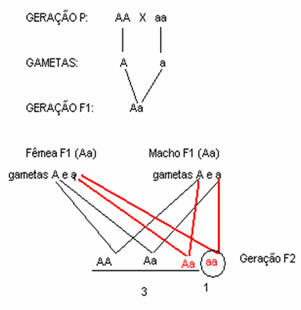Known as the father of genetics, Gregor Johann Mendel was born in what is now the Czech Republic. He entered the monastery at a young age, and there learned agricultural sciences and various techniques of artificial pollination, which allowed the crossing of several species of plants. Through his experiments, Mendel discovered and answered several questions about heredity.
The material chosen and used in his research was sweet pea (Pisum sativum). The reasons that led Mendel to choose this plant species were:
→ Easy cultivation;
→ Produces a large number of fertile offspring;
→Easily identifiable varieties with distinct characteristics;
→ Short life cycle, which allows several generations in a short time;
→ Ease of artificial pollination.
In his experiments, Mendel chose pure seed plants, for example yellow seed plants that gave rise only to yellow seeds, plants with green seeds that gave rise only to seeds green.
With the pure plants, Mendel crossed the male part of a yellow seed plant with the female part of another green seed plant. The first generation resulting from this cross (parental or P generation) he crossed with each other, obtaining the F1 generation (first hybrid generation), with all descendants of yellow seeds. Mendel called these individuals hybrids because they descended from parents with different characteristics (yellow and green seed). He noted that always, in the F1 generation, one feature stood out over the other.
After selfing one of these yellow seed hybrid individuals (F2 generation or second hybrid generation), he saw that 75% were yellow seeds and the remaining 25% were green seeds, in the proportion of 3 yellow seeds to 1 green seed (3:1).
Seeing this he found that some features are dominant over others. In this specific case, the yellow color is dominant, while the green color is recessive. In experiments with other parts of the plant, such as seed shape, flower color, plant size, he he came to the conclusion that some features always stand out from others, always in proportion to 3:1.
From these experiments, Mendel came to the conclusion that children inherit characteristics from their parents through genes. When the egg is fertilized by the sperm, the zygote is formed, which carries genetic information from the father and mother. The offspring will inherit only 1 gene of each trait from their parents, and only the dominant trait may be manifested.

Crossbreeding of pure individuals in the P generation
In the example above we illustrate the crossing of pure individuals in the P generation. Note that the gametes each individual carries are different. After crossing these individuals, we will have the F1 generation with the two gametes (A and a). Individuals from the F1 generation crossed giving rise to the F2 generation. Note that in the F2 generation we have offspring with dominant traits (A) and offspring with recessive traits (a), resulting in a 3:1 ratio.
By Paula Louredo
Graduated in Biology
